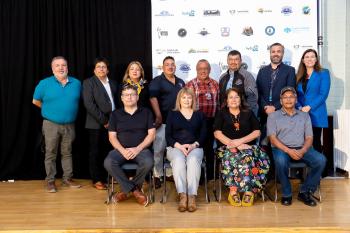Image Caption
Summary
Local Journalism Initiative Reporter
Windspeaker.com
The “gold standard” has been set with industry through an equal partnership model between First Nations in Ontario and Hydro One.
Hydro One, Ontario's largest electricity transmission and distribution provider, announced last week that, moving forward, First Nations in that province will have the opportunity to enter into 50/50 equity partnership agreements in any transmission line project with a value exceeding $100 million.
The first such equity partnership agreement was signed earlier this year on the Waasigan Transmission Line project with nine First Nations, eight comprising Gwayakocchigewin Limited Partnership (GLP) and Lac des Milles Lacs First Nation. That transmission line will add 350 megawatts of capacity to northwest Ontario.
In a statement, GLP says its goal is to achieve meaningful economic participation for its members, while protecting the lands, waters, and cultural values potentially impacted by the Waasigan project.
“I want to acknowledge not only our hard work that developed this partnership, but all the previous chiefs and previous councils that worked ever since treaty was signed. They have undauntedly said we need to be partners and to uphold the treaty as a 50/50 partner,” said Wabigoon Lake Ojibway Nation Chief Clayton Wetelainen, who also served as GLP’s spokesperson at the Sept. 22 announcement.
This equity model also applies to the five transmission lines Hydro One is developing in southwest Ontario.
“We didn’t start with a 50 per cent offer on the table. So there was a lot of moving and shaking and pushing that was going on, so that we were all going to be heard,” said Chief Mary Duckworth of the Caldwell First Nation.
Caldwell First Nation is among those in southwestern Ontario that will be involved with the other transmission lines recently approved by the province through the Ontario Energy Board. The four newly-approved lines are in addition to Hydro One's previous transmission designation for the Chatham to Lakeshore line in 2020.
Megan Telford, chief human resources officer for Hydro One, admitted that the company was led to equity partnership by the work undertaken by the First Nations.
“We consistently heard that a 50 per cent partnership was the desired outcome for industry to strive for. As part of corporate Canada, we have a deep and essential responsibility to reflect on our past and take meaningful action toward reconciliation with Indigenous communities,” said Telford.
She acknowledged that, in the past, utilities work was undertaken on First Nations lands with those territories bearing the impacts of development without seeing the benefits.
Telford pointed out that new transmission lines were required in Ontario as the province moved forward in meeting lower carbon emission requirements and clean energy.
“As your partner, we are committed to advancing our work and taking meaningful action to ensure your communities see the diverse benefits and opportunities from development,” said Telford.
Aamjiwnaang First Nation Chief Chris Plain said Hydro One’s equity partnership “fell in line” with the work his southwestern First Nation had been doing over recent years to raise own-source revenues to benefit community members in such areas as health, education, recreation and community safety.
Aamjiwnaang First Nation is located in the chemical valley, home to numerous refineries, energy projects, and is a hub for the transportation industry. Development has taken place there for decades without Aamjiwnaang experiencing the financial benefits.
“We’ve got a voice now and we’re correcting some of those past wrongs for the benefit of today and tomorrow’s generations in our community,” said Plain.
“Hydro (One) is the gold standard from this point on. And every proponent that comes to Caldwell First Nation better understand and recognize we will be 50 per cent or 51 per cent partners. We are not taking scraps anymore and we are not going to be sidelined,” said Duckworth.
Ontario Regional Chief Glen Hare said revenue sharing at 50 per cent with Hydro One meant First Nations would not be “going out looking and asking and begging for money to do something nice in our communities. We are going to be partners.”
In his 38 years as a leader, Hare said there were times when First Nations had negotiated hard for more than three per cent of revenue sharing and other times when they were forgotten. There were times, he said, when actions moved beyond the negotiation tables.
“I don’t know when the last time I stood in the middle of the highways blocking roads. That’s a good sign. I don’t ever want to stand on the road again with our chiefs. We don’t want to do that. That’s not our intent. Just work with us. We’re good people and we’re not going away,” said Hare.
Penny Favel, vice-president in charge of Indigenous relations for Hydro One, said some First Nations would be able to access the capital required for the 50 per cent partnership easier than other First Nations.
“The commitment from Hydro One is pretty clear on this. We are going to stand behind the First Nations. We are going to make sure that the funding is available at competitive rates so that we can get the equity investment activated,” said Favel.
Hydro One has also committed to increasing its Indigenous procurement spend to five per cent of all materials and services by 2026. This will ensure that 20 per cent of its corporate donations and sponsorships support Indigenous communities.
In 2021, Hydro One invested approximately $2.1 billion in its transmission and distribution networks and supported the economy through buying approximately $1.7 billion of goods and services.
Local Journalism Initiative Reporters are supported by a financial contribution made by the Government of Canada.

